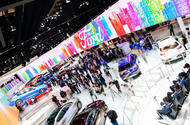First fully open post-pandemic show since 2019 will reveal the dramatic change that’s occurred in China’s car parc
In just over a month, the global automotive media will return to China en masse for the first time since the pandemic.
The 2024 Beijing motor show is the first to be held truly free of Covid restrictions, and therefore will be the first chance since 2019 for many to appreciate the dramatic change that has occurred in China’s car parc – and to the automotive industry in the world’s largest market.
For starters, the show stands (and the cars on them) from the domestic car makers will have a very different look and feel compared with five years ago. Long gone are the days of copycats and endless dull saloons, which have been replaced with genuinely cutting-edge electric cars.
Over the previous decade, the design and technology of Chinese cars quickly caught up with that of Western cars, and the driving dynamics soon followed suit. The branding of the companies themselves, and the way they presented themselves, was still not there by the end of the last decade, and checking in on progress there will be an intriguing plot line in Beijing. Given the quality of recent exports from the likes of Nio and BYD, I suspect the progression will be rapid there too.
Past visits to China have typically centred around watching the seemingly unstoppable expansion of Western brands into China, but the mood has shifted since. Now, the list of Western car makers struggling in China is increasing by the day, as leaner and more nimble Chinese manufacturers have overtaken them in creating the types of products Chinese buyers want – namely, desirable electric cars at a hugely competitive price.
This week, Porsche has cautioned on future growth in China due to the need to compete on price, which it is simply unable to do. “Value over volume” is the official line from Porsche and Volkswagen Group boss Oliver Blume, but his voice is the latest in talking down future growth prospects from a Western brand in China.
The likes of Ford, Jeep and General Motors, as detailed in a bulletin from Dunne Insights this week, are also suffering, sales having more than halved since 2017. The trio are labelled as “old-fashioned, out of step with the times” and slow to move to electric cars, according to one executive quoted in the piece. “Ford is losing buckets of money, operating at just 25% of its plant capacity,” read Dunne’s report.
The sudden rise of EV sales in China has been key in all this, and they are now over a third of market share and growing. Last year, Volkswagen was knocked off the top spot of the overall market by BYD and Chinese brands dominate the best-selling lists for electric cars.
Against this backdrop, you can see why some car makers, most notably Stellantis, are calling for tariffs to be introduced against Chinese exports. With the global direction of travel towards electric cars and the advantage Chinese brands enjoy here, the white flag is being raised in defeat against Chinese car makers in China, and now the fear is that the West’s domestic industries will be harmed with export, too.
It’s worth noting that this is not a universally held view from Western car makers. VW’s Blume, Renault’s Luca de Meo and Mercedes’ Ola Källenius are among those who think tariffs are unwarranted.
It’s all part of a clever long-term play from China. Western brands were invited into a market on the cusp of a boom, but only by entering into a joint venture with domestic car makers. This allowed Chinese companies to learn all about design, engineering and manufacturing of cars, while embedding an engrained cost advantage on materials and labour, and building towards a dominant position when electric cars boomed – as they now have.
The Beijing show will make a fascinating spectacle not only for the cars and companies at the show, but also where the biggest stories come from and how that will have shifted since 2019. For the first time – but certainly now not the last – I suspect the biggest and most globally significant news will come from the home-grown Chinese car makers going it alone.







